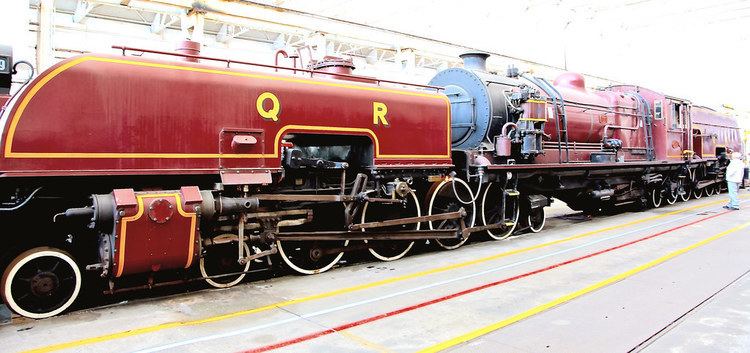Power type Steam Total produced 30 Gauge 1,067 mm (3 ft 6 in) | Build date 1950/51 Configuration 4-8-2+2-8-4 | |
Builder Beyer, Peacock & Co (10)Société Franco-Belge (20) Similar Garratt, Herbert William Garratt, South Australian Railways 400 class | ||

The Queensland Railways Beyer-Garratt class locomotive was a class of 4-8-2+2-8-4 steam locomotives operated by the Queensland Railways.
Contents
Overview
A Garratt (also known as Beyer-Garratt) is a type of steam locomotive that is articulated in three parts. Its boiler is mounted on the centre frame, and two steam engines are mounted on separate frames, one on each end of the boiler. Articulation permits larger locomotives to negotiate curves and lighter rails that might restrict large rigid-framed locomotives. Many Garratt designs aimed to double the power of the largest conventional locomotives operating on their railways, thus reducing the need for multiple locomotives and crews.
The initial plan had been to use these engines on the proposed air-conditioned trains that were being designed at the time. This never eventuated, although they did regularly haul the The Midlander, mainly between Emerald and Bogantungan for some years. They were used on the Rockhampton Mail and Sunshine Express in the early 1950s.
Builders
The first ten engines were constructed by Beyer Peacock, & Co, Manchester. Owing to a full order book, Beyer Peacock subcontracted the construction of the final 20 to Societe Franco Belge de Materiel du Chemins de fer, Raismes, France to build the remaining twenty.
Livery
All were painted Midland red and had chrome yellow lining with large QR monograms on the sides of the front tank and bunker. Unfortunately this attractive livery easily discoloured particularly as a result of priming. The engines were not regularly cleaned when relegated to goods train working in latter years and their appearance rapidly deteriorated.
Service
Originally trialled on the Brisbane to Toowoomba line, they were soon withdrawn from this section due to problems with limited clearances in the tunnels. They were used extensively on North Coast Line between Brisbane and Rockhampton. By 1956, this working had become restricted to mainly north of Bundaberg. They did not work north of St Lawrence on the North Coast Line. On the Central West Line they initially ran between Rockhampton and Emerald, and from 1957 their range was extended to Bogantungan.
A few were based at Mayne until 1955 and some at North Bundaberg until 1956, when all were allocated to Rockhampton. In later years they worked Moura coal trains via Mount Morgan, prior to the opening of the short line to Gladstone. One of their last regular tasks was on limestone trains between Tarcoola and Gladstone. Increasing numbers of diesels saw mass withdrawals of these engines. Twenty two were written off in June 1968.
Advantages and disadvantages
They were subject to much positive publicity when introduced but failed to live up to all expectations. They were attributed with saving 19,500 miles of assistant and goods engine running on the Bundaberg – Rockhampton – Emerald sections between October 1950 and June 1951. Steaming difficulties were encountered with South Queensland coals; however they performed well on Blair Athol coal. The boilers had a tendency to prime. Limited coal and water capacity caused worries. General overhauls cost about three times those for a B18¼ class.
Features
They had a number of unique features (for QR steam engines) including Ajax air operated butterfly fire doors, Hadfield power reverse gear, speedometers and also flow meters; the latter being fitted to the class in 1955.The outer bogies and inner trucks had roller bearings but the coupled axles has plain bearings. Several engines received fabricated stove pipe chimneys to replace the original cast ones that had been damaged.
Preservation
One has been preserved:
